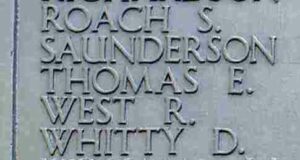Troedyraur is a parish four miles north-north-east of Newcastle Emlyn, which contains the village of Rhydlewis. The Parish Church, which is dedicated to St. Michael, contains a framed parchment scroll, which commemorates the men of the parish who fell during both World Wars. The list of the names has been kindly supplied by Sue Wright. I have taken the opportunity to add a couple of men to the list who appear to have been forgotten locally.
The Great War, 1914-1918
Eynon George Arthur Bowen, Lieutenant, Royal Flying Corps. Eynon was born on 19 August 1893, the son of Eynon George Rice Bowen and of Georgina Catherine Bowen, of Troedyraur, Cardiganshire. He had been a Scholar at Sherborne School, and had later attended the Royal Military Academy at Woolwich as a Cadet, before being gazetted Second Lieutenant into the Royal Garrison Artillery in December 1913. Eynon went to France with the RGA during June 1915, then volunteered for service with the Royal Flying Corps just two months later, qualifying first as an Observer, then as a Pilot on 6 March 1916. When he returned to the front he was posted to 22 Squadron. On 8 September 1916, Eynon was flying his FE2b, Serial 4921, with Lieutenant Robert Macallan Stalker acting as Observer, over Flers on the Somme Battlefield, when they unfortunately became a target for the German Ace, Oswald Boelcke, the man who trained Baron Manfred von Richtofen. Boelcke in his more able aeroplane shot down Eynon’s aeroplane in flames, killing both Eynon and Robert. As with so many other men of the RFC shot down in flames, their bodies were never recovered, and both men are commemorated on the Arras Flying Services Memorial, France. Eynon was 23 years old, and Robert was 25. Earlier that year, on 26 March 1916, Eynon’s father had passed away at the family’s home at Hambrook, near Bath, after being discharged from the Army, where he had served as a Lieutenant with the Army Service Corps Remounts Section, due to ill health.
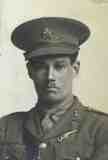
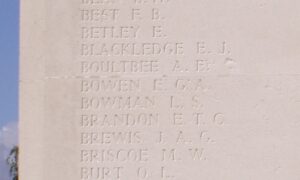
Rhys Davies, Private, 33009, South Wales Borderers. Rhys was the son of John and Mary Davies, of Penffos, Rhydlewis. He enlisted at Colwyn Bay into the South Wales Borderers, and was posted to France, joining the 1st Battalion, South Wales Borderers, which was attached to 3 Brigade, 1st Division. The Division had been in France since the outbreak of war, and had fought in the retreat from Mons, before moving to Ypres, fighting at the First and Second Battles of Ypres. In September 1915 the Division took part in the Battle of Loos, and in the summer of 1916 fought on the Somme. Rhys probably joined the battalion in time for the Somme offensive. They followed the German retreat to the Hindenburg Line in early 1917, and were then briefed for an operation on the Flanders Coast, and moved there during the summer of 1917. While training on the coast, the Battle of Third Ypres had stalled in the mire, and the Division was recalled to Ypres, where they fought at the Second Battle of Passchendaele. After spending another Winter in Flanders, they were near Estaires when the German Spring Offensive caught them, and saw heavy fighting over the coming weeks. Rhys was wounded during the relatively calm period after the German offensive had died down. He died of his wounds on 23 July 1918, aged 20, and is buried at Pernes British Cemetery, France.
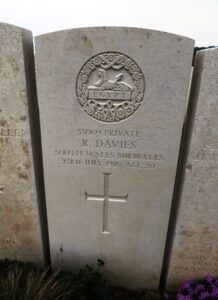
Tom Rees Davies, Lance Corporal, 7313, South African Infantry. Tom was the son of Rees and Maria Davies, of Ffoslas, Ffostrasol. He worked as a Carpenter prior to migrating to South Africa prior to the war. Tom enlisted into the 1st Regiment, South African Infantry, which was raised in Cape Province, joining the South African Infantry Brigade. In December 1915 the Brigade moved to Egypt, seeing action there against the Senussi tribesmen, before becoming transferred to France, joining the 9th (Scottish) Division. The Division then took part in the Battle of the Somme, fighting at the opening Battle of Albert, and then at the Battle of Bazentin, where they captured Longueval. They then fought at the Battle of Delville Wood, where the South Africans created a distinguished name for themselves. Tom was killed on the Somme on 18 October 1916. He was 33 years old, and is buried at Warlencourt British Cemetery, France.
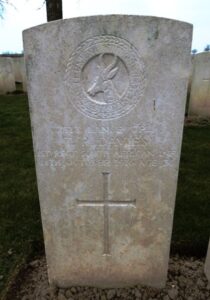
Fred Gaen, Private, 202068, Tank Corps. Fred was born in Cadoxton, Neath in 1890, the son of Charles and Elizabeth Gaen. He worked as an accountant prior to the war and married Olwen Myfanwy Thomas, the daughter of Enoch and Mariah Thomas, of Bronllys, near Troedyraur, in 1914. Fred enlisted into the Machine Gun Corps, and was posted to their Heavy Branch, which was later converted into the Tank Corps. During the Battle of Cambrai, Fred was serving with H Battalion, Tank Corps, which had been ordered to push through the Hindenburg Line towards Ribecourt. Despite heavy losses the Hindenburg Line was broken, but the Germans counter-attacked, beginning a series of desperate battles. A number of tanks from H Battalion were ordered to support an assault by the 51st (Highland) Division to recapture the village of Fontaine Notre Dame. Fred was killed when the battalion was withdrawing from the battle area on 1 December 1917. He was 27 years old and is commemorated on the Cambrai Memorial, Louverval. His brother in law, Ivan Arthur Lloyd Thomas, had been killed earlier that year, but neither appear to be commemorated locally. Fred is commemorated on Enoch and Mariah’s grave at Salem Chapel.
Dewi Jones, Private, 58236, South Wales Borderers. Dewi was the son of Daniel and Elizabeth Jones, of Penrhiw, Ffostrasol. He enlisted at Bath into the Army Service Corps, but later transferred into the 10th Battalion, South Wales Borderers, who were attached to 115 Brigade, 38th (Welsh) Division. The Division landed at Havre during December 1915, and moved to positions near Armentieres. They fought through some of the hardest and most famous battles of the Great War-at Mametz Wood during the Battle of the Somme, and at the Pilckem Ridge during the battle of Passchendaele. During September 1917 the Division was moved to the Armentieres sector, and remained here until being rushed to the Somme in April 1918, taking up positions around Aveluy Wood, near Albert. The German Spring Offensive had swept across the old Somme Battlefields, and had pushed the Allies back further than ever. However, the attack burnt itself out, and for several months this resulted in a stalemate settling along the line on the Somme. On 8 August 1918 a victory at Villers Brettoneux marked the turning point of the war, and the 38th Division launched an attack across the River Ancre on 21 August 1918, and over the coming days pushed the Germans back towards Bapaume. They then moved towards the Hindenburg Line, and fought at the Battle of Épehy, and on towards Cambrai. Dewi was killed in action, aged 20, on 8 October 1918. He is buried at Guizancourt Farm Cemetery, Gouy, France.
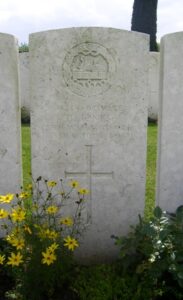
Evan John Jones, Driver, 19801, Royal Field Artillery. Evan was the son of John and Margaret Jones, of Cwmbwch, Rhydlewis. He enlisted at Newport, Monmouth into the Royal Field Artillery, and was posted to France on 2 September 1915, joining C Battery, 75th Brigade, Royal Field Artillery, which was attached to the Guards Division. Evan wasn’t to experience much of the war. He died on 20 September 1915, aged 25, and is buried in Bethune Town Cemetery, France.
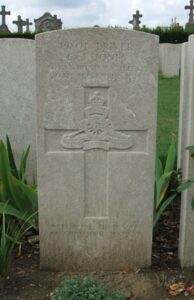
William Jones, Private, 2346, Welsh Regiment. William was the son of John and Elizabeth Jones, of Capel Farm, Ffostrasol. He enlisted on 4 September 1915 into the 3/4th Battalion, Welsh Regiment, which was a reserve battalion for the 1/4th Welsh, which was in the Mediterranean, attached to the 53rd (Welsh) Division. On 11 July 1916 William was discharged from the army as medically unfit, after having blown three fingers off his right hand whilst out shooting. William died of angina within weeks of being discharged, on 29 July 1916. He was 20 years old, and is buried at Bwlchygroes Independent Chapelyard. William is commemorated on the Bwlchygroes Memorial.
Herbert James Graham Kell, Master Mariner, Mercantile Marine. Herbert was born at Edinburgh on 29 September 1874, the son of James Graham Kell and Cordelia Graham Kell (nee Cannon). His father was a Civil Engineer and moved the family to Gwernant, Troedyraur, near Newcastle Emlyn, by 1881. Herbert entered Christ College in 1888 together with an older brother, Fergus Aenas Kell, and a younger brother, Philip Arthur Graham Kell. After leaving school two years later, both Herbert and Philip became apprentices in the Mercantile Marine. Herbert joined Wright, Graham & Co at Glasgow on 13 October 1892, whilst Philip joined Macvicar, Marshall & Co at Barry on 28 September 1892. Herbert thrived at sea, gaining his certificate as Second Mate on 4 July 1895, then of First Mate on 3 November 1899. On 12 April 1901 he gained his certificate as Master of a foreign-going ship, which allowed him to Captain his own vessels. Herbert emigrated to Australia in 1909 where he joined the shipping firm of Huddart Parker & Co of Melbourne, and over the coming years took command of several vessels. By the beginning of 1915 he had been given command of the passenger ship SS Wimmera, which operated on the trans-Tasman Sea run between Australia and New Zealand. He then married an English ex-pat, Christina Mary Wallas, and the couple set up their home at Auckland. Herbert continued to Captain Wimmera after his marriage. On the morning of 25 June 1918, Wimmera left Auckland on a routine voyage bound for Sydney, carrying 76 passengers and 75 crew. At 05.15 on 26 June 1918, she hit a mine which had been laid by the German commerce raider SMS Wolf and sank rapidly. Herbert, together with 25 others, were lost during the sinking of Wimmera that day. The 45-year-old has no known grave but the sea, so is commemorated on the Tower Hill Memorial, London. His younger brother, Philip Arthur Graham Kell, had become the first former pupil of Christ College to fall during the war, when he was lost aboard HMS Cressy in September 1914. Herbert does not appear to be commemorated locally.
Philip Arthur Graham Kell, Lieutenant, Royal Naval Reserve. Philip was born at Gwernant, Troedyraur on 2 May 1876, the youngest son of James Graham Kell and Cordelia Graham Kell (nee Cannon). His father was a Civil Engineer and had moved the family to Gwernant, Troedyraur, near Newcastle Emlyn just prior to Philip’s birth. Philip entered Christ College in 1888 together with his older brothers, Fergus Aenas Kell, and Herbert James Graham Kell. After leaving school two years later, both Philip and Herbert became apprentices in the Mercantile Marine: Philip joined Macvicar, Marshall & Co at Barry on 28 September 1892, whilst Herbert joined Wright, Graham & Co at Glasgow on 13 October 1892. Philip gained his certificate as Second Mate on 31 October 1895, then as First Mate on 28 April 1898, before gaining his certificate as Master of a foreign-going ship on 3 March 1900. Philip had also gained a commission into the Royal Naval Reserve on 29 September 1898, the naval version of the Territorial Army, and over the coming years served aboard HMS Cambridge, HMS Defiance and HMS Galatea. Philip married Belissa Elenor Kathleen Smyly at Ballymoney in 1912, and then left Britain to work for the Uganda Railway at Lake Marine, Uganda, where their only child, Fergus Hugh Graham Kell, was born in 1913. Philip returned to sea following the outbreak of war, returning to Britain to be re-commissioned as Lieutenant into the Royal Naval Reserve and was posted aboard the armoured cruiser HMS Cressy. She was an antiquated ship which had been re-commissioned from reserve, joining the 7th Cruiser Squadron, which was tasked with patrolling the Broad Fourteens of the North Sea in support of a force of destroyers and submarines based at Harwich. Cressy saw action during the Battle of Heligoland Bight on 28 August 1914, taking a large number of rescued German sailors back to England. On the morning of 22 September 1914, Cressy and her sister ships, Aboukir and Hogue, were on patrol without any escort, steaming in line abreast when they were spotted by the German submarine U-9. The Germans fired a single torpedo at Aboukir, which struck her on the starboard side. The ships captain thought he had struck a mine, so ordered Cressy and Hogue to pull to so he could evacuate his wounded men, before Aboukir sank some 35 minutes later. Hogue pulled up to pick up survivors but was hit by two torpedoes from U-9 and sank within twenty minutes, whilst Cressy, which had attempted to ram the submarine, was hit by a single torpedo in the engine room which caused her boilers to explode and she sank within 25 minutes. From all three ships 837 men were rescued and 62 officers and 1,397 ratings lost, the bulk of them from Cressy. Philip was 38 years old when he was killed during the sinking of Cressy that morning. He has no known grave, so is commemorated on the Chatham Naval Memorial, Kent. His elder brother, Herbert James Graham Kell, was lost at sea in 1918, whilst their eldest brother, Fergus, died in Taiwan on 18 October 1915. Philip does not appear to be commemorated locally.
William Morgan Lewis, First Mate, Mercantile Marine. William was the son of David and Betsy Lewis, of Waun Villa, Rhydlewis. He served with the Mercantile Marine aboard the SS Snowdon, a London registered steamer. On 19 May 1918, Snowdon was on voyage from Cardiff to Milos with a cargo of coal, when she was sunk by the German submarine U-63, 84 miles off Malta, with the loss of two lives. William was 28 years old when he drowned that day, and is commemorated on the Tower Hill Memorial, London.
John Lewis Owen, Master, Mercantile Marine. John was the son of Thomas and Sarah Owen, of Wynebhwnt, Rhydlewis. He served with the Mercantile Marine as Master of the SS Snowdon, a London registered steamer. On 19 May 1918, Snowdon was on voyage from Cardiff to Milos with a cargo of coal, when she was sunk by the German submarine U-63, 84 miles off Malta, with the loss of two lives. John was 29 years old when he died that day, and is commemorated on the Tower Hill Memorial, London.
David John Thomas, Private, 561, Australian Infantry. David was born at St. Dogmaels, the son of Lewis and Elizabeth Thomas, later of Brynteg, Henllan. He had emigrated to Australia prior to the war along with his brother James Louis Thomas, and after the declaration of war, both brothers enlisted into the Australian Imperial Force. David attested at Perth into the 44th Battalion, AIF, and embarked at Fremantle on 6 June 1916 aboard the HMAT Suevic, bound for England. David was then posted to his Battalion in France on 16 March 1917, after spending two months in hospital in England. The Battalion spent most of May 1917 training near Armentieres, and at the end of the month moved to Ploegsteert, where they took up billets in the catacombs, providing working parties within the wood. David was killed during his first day at Ploegsteert on 1 June 1917. He was 34 years old, and is buried at Strand Military Cemetery, Belgium. His Brother, James Louis Thomas, died the previous year.
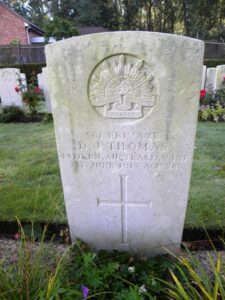
Ivan Arthur Lloyd Thomas, Second Lieutenant, Machine Gun Corps. Ivan was born at Llangadog, Carmarthenshire on 14 January 1887, the son of Enoch and Mariah Thomas. The family later resided at Bronllys, near, Newcastle Emlyn. Ivan was educated at Aberystwyth University and served for three years with the University OTC before becoming a teacher in Canada prior to the war. He enlisted at Montreal on 16 September 1915 into the Canadian Expeditionary Force and soon after arriving in England was commissioned on 25 October 1916 into the Machine Gun Corps. Ivan was posted to their 142nd Company, which was attached to the 47th (2nd London) Division. The Division was north of Arras when the Germans attacked Vimy Ridge, and then moved south to the Somme, where they fought at the Battle of Flers-Courcelette, and then at the Battle of Le Transloy, where the Division captured Eaucourt l’Abbe, and took part in Attacks on the Butte de Warlencourt. Early in 1917 the Division moved north to Belgium. Ivan was killed in action at Ypres on 10 May 1917. He was 30 years old, and is buried at Bedford House Cemetery, Belgium. He is not commemorated at Troedyraur, but is named on the Aberystwyth University War Memorial.
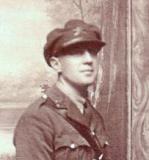
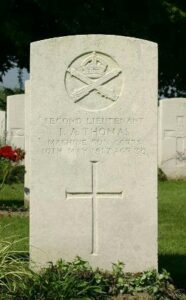
James Louis Thomas, Private, 2936, Australian Infantry. James was born at St. Dogmaels, the son of Lewis and Elizabeth Thomas, later of Brynteg, Henllan. He had emigrated to Australia along with his brother David prior to the war, and enlisted there at Blackboy Hill into the Australian Imperial Force. James was posted to the 48th Battalion, AIF, which was in France attached to the 12th Australian Brigade, 4th Australian Division. On 5 October 1915 James embarked at Fremantle aboard the HMAT Hororata, and arrived at Ismailia on 8 January 1916. On 9 June 1916 the 48th Battalion landed at Marseilles, and moved to Bailleul. The Division moved to the Somme at the end of July 1916, and took up positions in Sausage Valley, while the 2nd Australian Division was fighting at Pozieres, and got ready to move into the line to replace them. James was killed just days after, when his battalion moved through the battered ruins of Pozieres, to attack the German positions near the Windmill on 6 August 1916. He was 33 years old, and is commemorated on the Villers-Bretonneaux Memorial, France. His brother David was killed at Ypres the following year.
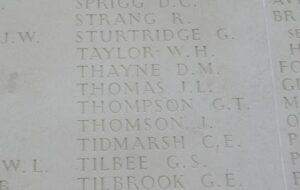
World War Two, 1939-1945
David Joshua Lloyd Davies, Fusilier, 7046611, Royal Irish Fusiliers. David was the son of Evan Arthur and Elizabeth Davies, of Gwalia, Rhydlewis. He served with the 1st Battalion, Royal Irish Fusiliers, which was attached to the 38th Irish Infantry Brigade. The brigade served in the North African campaign. David was killed in Tunisia, during the Battle of the Kasserine Pass, on 20 February 1943. He was 29 years old, and is commemorated on the Medjez-El-Bab Memorial, Tunisia.
Gwyn Davies, Private, 3963443, Welch Regiment. Gwyn was the son of Daniel and Esther Davies, of Maesllyn. He served with the Welch Regiment and died at home on 1 September 1944, aged 29. Nothing further is known of him, but he is buried in Brongest (Salem) Presbyterian Chapelyard. He does not appear to be commemorated locally.
Emlyn Thomas, Sailor, Merchant Navy. Emlyn was the son of John and Elizabeth Thomas, of Tanrallt, Sarnau, and the husband of Ada Thomas, of Talog, Carmarthenshire. He served with the Merchant Navy aboard the MV San Emiliano, a London registered tanker. On 9 August 1942 she was on route from Curacoa for Trinidad and Table Bay carrying a cargo of aviation spirit, when she was torpedoed by the German submarine U-155, and sank with the loss of 39 lives. Emlyn was 22 years old when he died that day, and is commemorated on the Tower Hill Memorial, London. Emlyn isn’t named on the framed roll of honour, but is commemorated by a brass cross which is located within the Church.
